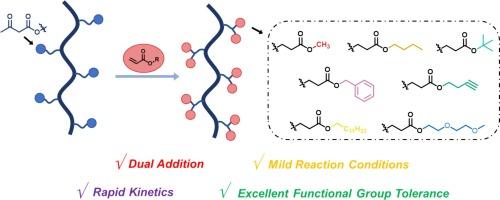Efficient and facile dual post-polymerization modification using acetoacetate-acrylate Michael addition
IF 5.8
2区 化学
Q1 POLYMER SCIENCE
引用次数: 0
Abstract
Post-polymerization modification (PPM) is a valuable strategy for achieving diversified functional polymers; nonetheless, the pursuit of achieving mild and efficient dual modification along the polymeric backbone remains as a challenge. In this work, the Michael addition reaction of acetoacetates and acrylates have been demonstrated as a robust PPM technique. The reversible addition-fragmentation chain transfer polymerization of commercially available 2-(acetoacetoxy)ethyl methacrylate provides a polymer scaffold with controlled molecular weight and acetoacetate groups. These pendant groups are capable of undergoing efficient double addition reactions with acrylates, leading to an increased density of functional moieties within the polymeric backbone. This PPM reaction exhibits unique advantages such as mild reaction conditions (at 40 °C), rapid kinetics (completion within 1 h), and high atom economy. Consequently, a series of polymers with tunable thermal stability, glass transition temperature, and hydrophilicity have been successfully synthesized. Applications have been demonstrated for both the synthesis of polymers exhibiting aggregation-induced luminescence and the preparation of luminescent materials with adjustable mechanical properties. This pioneering work unveils a robust post-polymerization modification technique, significantly advancing the synthesis of innovative functional polymers.

利用乙酰乙酸酯-丙烯酸酯迈克尔加成法进行高效、简便的双重聚合后改性
聚合后改性(PPM)是实现功能聚合物多样化的重要策略;然而,如何在聚合物骨架上实现温和、高效的双重改性仍然是一项挑战。在这项研究中,乙酰乙酸酯和丙烯酸酯的迈克尔加成反应被证明是一种可靠的 PPM 技术。通过对市售 2-(乙酰乙酰氧基)甲基丙烯酸乙酯进行可逆加成-碎片链转移聚合反应,可获得具有可控分子量和乙酰乙酸酯基团的聚合物支架。这些悬垂基团能够与丙烯酸酯发生高效的双加成反应,从而增加聚合物骨架中功能分子的密度。这种 PPM 反应具有独特的优势,如反应条件温和(40 °C)、动力学反应迅速(1 小时内完成)和原子经济性高。因此,我们成功合成了一系列具有可调热稳定性、玻璃化温度和亲水性的聚合物。在合成具有聚合诱导发光特性的聚合物和制备具有可调机械特性的发光材料方面的应用已得到证实。这项开创性工作揭示了一种强大的聚合后改性技术,极大地推动了创新功能聚合物的合成。
本文章由计算机程序翻译,如有差异,请以英文原文为准。
求助全文
约1分钟内获得全文
求助全文
来源期刊

European Polymer Journal
化学-高分子科学
CiteScore
9.90
自引率
10.00%
发文量
691
审稿时长
23 days
期刊介绍:
European Polymer Journal is dedicated to publishing work on fundamental and applied polymer chemistry and macromolecular materials. The journal covers all aspects of polymer synthesis, including polymerization mechanisms and chemical functional transformations, with a focus on novel polymers and the relationships between molecular structure and polymer properties. In addition, we welcome submissions on bio-based or renewable polymers, stimuli-responsive systems and polymer bio-hybrids. European Polymer Journal also publishes research on the biomedical application of polymers, including drug delivery and regenerative medicine. The main scope is covered but not limited to the following core research areas:
Polymer synthesis and functionalization
• Novel synthetic routes for polymerization, functional modification, controlled/living polymerization and precision polymers.
Stimuli-responsive polymers
• Including shape memory and self-healing polymers.
Supramolecular polymers and self-assembly
• Molecular recognition and higher order polymer structures.
Renewable and sustainable polymers
• Bio-based, biodegradable and anti-microbial polymers and polymeric bio-nanocomposites.
Polymers at interfaces and surfaces
• Chemistry and engineering of surfaces with biological relevance, including patterning, antifouling polymers and polymers for membrane applications.
Biomedical applications and nanomedicine
• Polymers for regenerative medicine, drug delivery molecular release and gene therapy
The scope of European Polymer Journal no longer includes Polymer Physics.
 求助内容:
求助内容: 应助结果提醒方式:
应助结果提醒方式:


